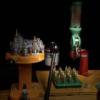The impetus for the 6.8mm round seems to be an Army requirement that a tungsten-free version of the selected caliber/cartridge be able to penetrate all known body armors at 500 meters, not just at point blank range. The best in class body armors in question appear to be recent Chinese and Russian developments.
The M995 tungsten cored 5.56mm cartridge is said to penetrate all known body armors inside 200 meters, but not beyond. It has also not performed consistantly at point blank range due to bullet stability issues. The M855 5.56mm cartridge and its developments are unable to penetrate best in class body armors at all ranges.
Penetration of body armors is believed to require a certain level of retained kinetic energy, which is why 6.8mm calibers have been selected. They are capable of delivering the retained energy desired at 500 meters.
Results 11 to 20 of 26
-
04-11-2019, 09:37 AM #11I am a Forum User












- Join Date
- Dec 2010
- Location
- West of Bravo
- Posts
- 7,512
-
04-11-2019, 10:27 AM #12I am a Forum User












- Join Date
- Jan 2003
- Location
- Livingston Co.
- Posts
- 19,771
-
04-11-2019, 11:36 AM #13I am a Forum User












- Join Date
- Dec 2010
- Location
- West of Bravo
- Posts
- 7,512
By 1968, most of the problems which initially plagued the M16 Rifle had been worked out, thanks to Congressman Ichord's relentless efforts in 1966 and 1967.
DTIC has posted the once classified June 1968 Report of the M16 Rifle Review Panel (AD A953117) online and it is a good analysis of the status of the M16 Rifle in 1968:
https://apps.dtic.mil/dtic/tr/fulltext/u2/a953117.pdf
-
04-11-2019, 11:55 AM #14I am a Forum User












- Join Date
- Jan 2003
- Location
- Livingston Co.
- Posts
- 19,771
-
04-11-2019, 07:40 PM #15I am a Forum User












- Join Date
- Apr 2008
- Location
- N.Oakland/S.Genesee County
- Posts
- 3,729
I read it was the change in propellant that changed the cyclical rate of fire, causing misfeeds, and the non chrome lined chamber and bores which were the major factors in the M-16 being a lemon. My FIL was in Vietnam and used the M-14 in basic and they switched to the m-16 once he went to advanced training. He was issued an m-16 n Vietnam and said the m-14 was great and the M-16 was terrible.
-
04-11-2019, 08:34 PM #16I am a Forum User












- Join Date
- Jan 2003
- Location
- Livingston Co.
- Posts
- 19,771
-
04-11-2019, 09:18 PM #17I am a Forum User












- Join Date
- Dec 2010
- Location
- West of Bravo
- Posts
- 7,512
No .22 caliber cleaning kits were issued until 1967. M14 rods would not go through the bore. Chamber brushes were nonexistent in 1965, 1966, and 1967; still in short supply in 1968. Bore solvent issued didn't remove crud within the bolt carrier bolt socket. Didn't remove copper fouling either, so bullets were tumbling from the muzzle on in high round count rifles. Lubricant issued didn't adhere to surfaces in the hot, humid climate.
GI's were oiling cartridges to assure extraction from pitted chambers, which penetrated to the propellant. Broken extractors and extractor springs were an epidemic because there were no spare parts in country. GI's did not clean their magazines, which were biological breeding factories. Were loading 21 rounds in magazines. Didn't clean their weapons regularly because everyone knows aluminum doesn't rust.
DuPont propellant (IMR 8208) did not deliver the specified 3,250 fps velocity at acceptable chamber pressures from the second powder lot on. Western ball propellant (WC 844) delivered the specified velocity only in some lots. Slightly slower WC 846 reliably delivered specified velocity, but increased gas port pressure (which had never been specified by either ArmaLite or Colt). Ball powders used were all made from recycled WW II naval propellant stocks and had far too much calcium carbonate (to stem chemical deterioration which was already well underway) which seized up the bolt in the bolt carrier. Hercules flake powders blew up guns on an irregular, but frequent basis.
Whiz Kid McNamara and his military yes men screwed this rifle roll out, right from the start.
-
04-12-2019, 04:22 AM #18I am a Forum User


- Join Date
- Mar 2019
- Location
- New Hudson
- Posts
- 31
-
04-12-2019, 06:39 AM #19I am a Forum User












- Join Date
- Dec 2010
- Location
- West of Bravo
- Posts
- 7,512
The "BHN 150" on the upper right hand corner of the plate means 150 on the Brinell hardness scale. This is a nice, low end ASTM A36 mild steel plate, confirmed by the "MS" also written on the plate.
Standard MIL-DTL-46100E RHA armor plate runs 477 - 534 BHN. High performance MIL-A-46099C DHA armor plate has a 601 - 712 BHN strike face roll bonded to a 461 - 534 back plate.
Armor plate (and armor piercing projectile) performance is tested by determining the 'V50' velocity (half of projectiles pass through a given thickness of MIL-DTL-46100E RHA armor plate) according to MIL-STD-662F test procedures.
Punching holes in 3/8 inch thick mild steel has no relevance in today's military environment, nor does it predict performance on body armor.
-
04-12-2019, 09:11 AM #20"Saepe errans, numquam dubitans --Frequently in error, never in doubt".
The trouble with the Internet is that it's replacing masturbation as a leisure activity. ~Patrick Murray
Tags for this Thread
|
|




 Reply With Quote
Reply With Quote







